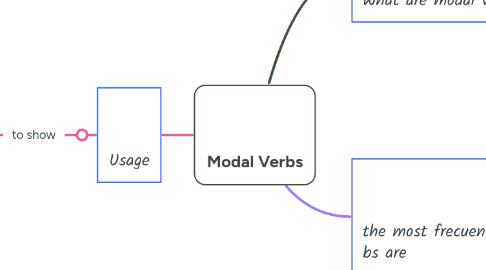
1. Usage
1.1. to show
1.1.1. likelihood
1.1.1.1. In situations when something is possible but not certain, use the modal verbs could, may, or might.
1.1.1.2. example
1.1.1.2.1. Her parents must be so proud. My baby brother should be asleep by now.
1.1.2. possibility
1.1.2.1. In situations when something is possible but not certain, use the modal verbs could, may, or might.
1.1.2.2. example
1.1.2.2.1. Judging by the clouds, it might rain today.
1.1.3. habit
1.1.3.1. To show an ongoing or habitual action—something the subject does regularly—you can use the modal verb would for the past tense and will for the present and future. The phrase used to is also acceptable if you’re talking about a habit that no longer exists.
1.1.3.2. example
1.1.3.2.1. When I lived alone, I would fall asleep with music.
1.1.4. ability
1.1.4.1. The modal verb can shows whether or not the subject is able to do something, such as perform an action or demonstrate an ability. Likewise, the negative form, cannot or can’t, shows that the subject is unable to do something.
1.1.4.2. example
1.1.4.2.1. She can speak three languages, but none of them well.
1.1.5. asking permission
1.1.5.1. If you want to ask permission to do something, start your question with can, may, or could. Traditionally, in more formal and polite usage, may is better for permission
1.1.5.2. example
1.1.5.2.1. May I leave early today?
1.1.6. request
1.1.6.1. Similarly, if you want to ask someone else to do something, start your question with will, would, can, or could.
1.1.6.2. example
1.1.6.2.1. Would you get that box off the top shelf?
1.1.7. comand
1.1.7.1. On the other hand, if you want to command someone, use the modal verbs must, have to, or need to.
1.1.7.2. example
1.1.7.2.1. You must wash your hands before cooking.
1.1.8. obligation
1.1.8.1. Modal verbs can express a necessary action, such as an obligation, duty, or requirement. Likewise, the negative form expresses that an action is not necessary. Use the same modal verbs as with commands: must, have to, or need to.
1.1.8.2. example
1.1.8.2.1. We have to wait for our boss to arrive before we open.
2. What are modal verbs?
2.1. Modal verbs show possibility, intent, ability, or necessity. Because they’re a type of auxiliary verb (helper verb), they’re used together with the main verb of the sentence.
2.2. examples
2.2.1. can, should, may, might...
